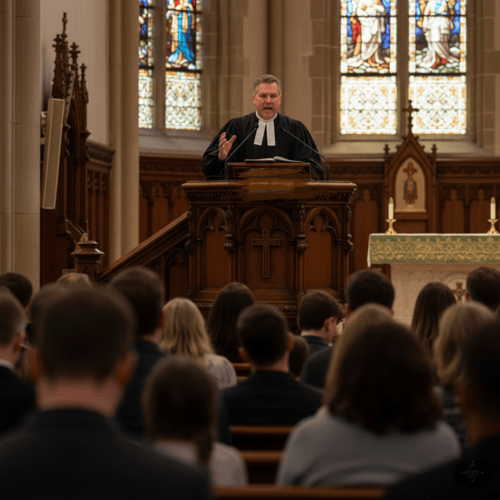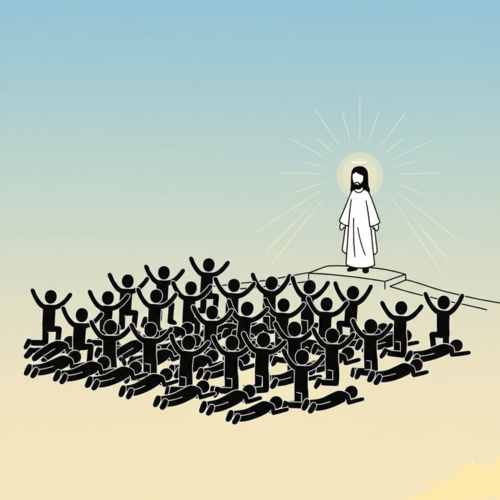The Beatific Vision: What Will It Mean to See God Face to Face?
REFORMED PERSPECTIVES ON OUR ETERNAL JOY
“Blessed are the pure in heart, for they shall see God.” (Matthew 5:8)
What is the ultimate goal of salvation? Many Christians may answer it is escape from judgement. Or they may say it is eternal life, or heaven. While true, these answers fall short of the breathtaking reality the Bible presents. The highest purpose and greatest joy of salvation is the Beatific Vision—seeing God face to face in unmediated glory.
This vision isn’t merely one blessing among many; it’s the culmination of everything God has promised since the beginning. It’s the moment when faith becomes sight, when the One who has captivated our hearts becomes the One who fills our vision for all eternity.
THE COVENANT JOURNEY TO SEEING GOD’S FACE
From a Reformed perspective, the Beatific Vision (from Latin visio beatifica, “vision of blessedness”) makes most sense within the framework of covenant theology. Throughout Scripture, God’s covenant promise echoes: “I will be your God, and you will be my people.” This relationship, established by grace alone, has always been moving toward one magnificent conclusion: perfect communion.
Consider the progression:
- In Eden, Adam and Eve enjoyed fellowship with God, yet even this was preparatory—a foretaste of greater glory.
- Throughout Israel’s history, God’s people glimpsed Him through types and shadows—the tabernacle, the temple, the sacrificial system—all veiled revelations.
- In Christ, we see the Father more clearly: “Whoever has seen me has seen the Father” (John 14:9). Yet even this revelation, glorious as it is, remains mediated through Christ’s humanity.
- When we’re glorified, the covenant reaches its fulfillment. The veil is removed completely, and we shall behold God directly.
The Beatific Vision isn’t an add-on to salvation; it’s what everything has been building toward since “Let there be light.”
WHAT SCRIPTURE REVEALS ABOUT SEEING GOD
The Bible speaks with anticipation about this face-to-face encounter with God:
In the Old Testament, we find powerful foreshadowing:
- Moses boldly asked to see God’s glory and received a partial glimpse, protected by God’s hand (Exodus 33:18-23).
- Job, in the midst of suffering, found hope in declaring, “In my flesh I shall see God” (Job 19:26).
- David expressed his ultimate satisfaction: “As for me, I shall behold your face in righteousness; when I awake, I shall be satisfied with your likeness” (Psalm 17:15).
The New Testament transforms these shadows into promises:
- “We shall see him as he is” (1 John 3:2)—not dimly, not partially, but clearly and fully.
- Paul contrasts our current limited perception with what awaits: “Now we see in a mirror dimly, then face to face. Now I know in part; then I shall know fully, even as I have been fully known” (1 Corinthians 13:12).
- Revelation culminates with this promise: “They will see his face” (Revelation 22:4).
Scripture consistently points to this vision as our ultimate hope and destiny.
WHAT WILL THIS VISION BE LIKE?
The Beatific Vision engages our whole being:
Perfect Knowledge: We will know God with unprecedented clarity and intimacy. This isn’t merely theological information but relational knowing—the difference between reading about someone and living with them. “Then I shall know fully, even as I have been fully known” (1 Corinthians 13:12).
Perfect Joy: Seeing God produces unimaginable delight. As the Psalmist writes, “In your presence there is fullness of joy; at your right hand are pleasures forevermore” (Psalm 16:11). Every earthly joy is merely a shadow of this experience.
Perfect Transformation: The vision itself transforms us. “We shall be like him, because we shall see him as he is” (1 John 3:2). Beholding God’s glory completes our sanctification, conforming us fully to Christ’s image.
WHY WE CAN’T SEE CLEARLY NOW
Our current limitations are profound:
- We live by faith, not sight (2 Corinthians 5:7). Sin has veiled our spiritual perception. We’re like people trying to identify someone through frosted glass—we see outlines and movement but not details.
- Our knowledge of God, while true, remains partial. Even the most profound theological insights are like describing a sunrise to someone who has never seen colors.
- Christ mediates our current knowledge: “No one has ever seen God; the only God, who is at the Father’s side, he has made him known” (John 1:18). We see the Father through the Son, but even this revelation is adapted to our current capacity.
THE DISTINCTLY REFORMED UNDERSTANDING
The Reformed perspective on the Beatific Vision differs from other traditions in important ways:
Unlike the Roman Catholic view, we understand the vision not as a reward earned through merit but as the fulfillment of covenant grace. It’s not primarily an intellectual abstraction but a personal communion secured entirely by Christ’s work.
Unlike some Eastern Orthodox formulations, Reformed theology doesn’t require a distinction between God’s essence and energies to explain how finite beings can see the infinite God. Instead, we emphasise glorified believers will be enabled through Christ to see God as He has revealed Himself.
Unlike the Arminian/Wesleyan perspectives, the Reformed view grounds the vision in God’s sovereign, immutable purpose rather than human cooperation. The Beatific Vision is the inevitable culmination of effectual calling and perseverance—what God begins, He completes (Philippians 1:6).
LIVING NOW IN LIGHT OF THEN
How should the promise of seeing God shape our lives today?
- Motivation for holiness: “Everyone who thus hopes in him purifies himself as he is pure” (1 John 3:3). When we grasp that we’re being prepared to see God face to face, purity becomes not just a duty but a preparation.
- Perspective in suffering: “The sufferings of this present time are not worth comparing with the glory that is to be revealed to us” (Romans 8:18). Our hardships, viewed through the lens of the coming vision, are placed in proper perspective.
- Practice of spiritual sight: Through Scripture, prayer, worship, and sacrament, we can cultivate spiritual vision now. These disciplines don’t create the Beatific Vision, but they train our souls to recognize and desire God’s presence.
- Reordered priorities: Knowing that we will one day see God face to face helps us hold earthly things loosely. Success, comfort, and security take their proper place when we live for what’s eternal.
THE BEATIFIC VISION: TRULY SATISFYING
The Beatific Vision is the consummation of all God’s purposes—not an escape from creation but its fulfillment. It’s the answer to humanity’s deepest longing, even when we can’t name what we’re searching for.
Augustine captured this truth: “You have made us for yourself, O Lord, and our heart is restless until it rests in you.” That rest finds its completion when faith becomes sight, when we no longer see “through a glass darkly,” but face to face.
Every glimpse of beauty, every moment of joy, every experience of love points toward this reality. One day, we will see the source of all these things directly. We will see God—and in seeing Him, find the fulfillment of everything we were created to be.
Until that day, may we fix our eyes on “what is unseen, for what is seen is temporary, but what is unseen is eternal” (2 Corinthians 4:18).
”For now we see in a mirror dimly, but then face to face. Now I know in part; then I shall know fully, even as I have been fully known.” (1 Corinthians 13:12)
THE BEATIFIC VISION: RELATED FAQs
Will we see God the Father, Son, and Holy Spirit distinctly in the Beatific Vision? While maintaining the unity of the divine essence, Reformed theology typically affirms we shall perceive the distinct persons of the Trinity. Since Christ retains his glorified humanity eternally, we will see him in his glorified human nature while also perceiving his divine nature. The Reformed tradition maintains we shall see the Father and Spirit not with physical eyes but through our glorified spiritual perception.
Will there be degrees of enjoyment in the Beatific Vision? Following Jonathan Edwards and others, Reformed theologians hold all believers will fully enjoy the Beatific Vision, but our capacity for enjoyment may differ according to God’s sovereign distribution of grace. Like vessels of various sizes, all filled to capacity, each believer experiences complete joy, while the absolute measure may vary.
How does the Beatific Vision relate to the New Creation and our resurrected bodies? The Beatific Vision occurs within, not apart from, the renewed creation. Our glorified physical bodies will participate in this vision—not just disembodied souls contemplating deity. The whole person, body and soul reunited and glorified, experiences God’s presence in a renewed cosmos.
Will we still need Scripture after we see God face to face? While we won’t need Scripture for its revelatory function (since we’ll see directly what Scripture now reveals partially), many Reformed thinkers suggest the Bible will remain eternally significant as the historic covenant document, cherished for how it brought us to glory. Scripture may continue as the language of eternal worship, its promises now fulfilled providing the vocabulary with which we praise the One we see.
How does the already/not yet tension apply to the Beatific Vision? Through union with Christ, believers already experience a foretaste of the Beatific Vision. Paul speaks of “beholding the glory of the Lord” even now, being “transformed into the same image” (2 Corinthians 3:18). What we now see “in a mirror dimly” is genuinely the same glory we will later see “face to face.”
Will the Beatific Vision ever become routine or less amazing through eternity? Unlike temporal pleasures that diminish with familiarity, the Beatific Vision will sustain eternal wonder because God’s infinite nature can never be exhaustively known by finite creatures. As Jonathan Edwards argued, we will continuously discover new aspects of God’s glory without ever reaching its end.
How does belief in the Beatific Vision distinguish Christianity from other religions? Unlike Eastern religions seeking absorption into an impersonal divine, or philosophical traditions viewing God as ultimately unknowable, Reformed Christianity promises personal communion with a personal God. We don’t lose our identity but find it perfected in relationship. The Christian promise of seeing God face to face fulfils what philosophers and mystics throughout history have sought but never fully articulated—direct, transformative knowledge of ultimate reality that doesn’t destroy but perfects the knower.
THE BEATIFIC VISION: OUR RELATED POSTS
Editor's Pick

Faithful to the Pattern: Why Paul Reserves Ordination for Men
Few topics in contemporary Christianity generate more tension than women’s ordination. This question touches real lives, genuine callings, and deeply [...]

‘Flee Sexual Sin’: Why Does Paul Single This Sin Out?
When the apostle Paul writes to the Corinthian church, he doesn’t tell them to simply avoid sexual immorality or resist [...]

Does Denying God’s Sovereignty Mean Denying the Gospel?
RC Sproul once warned denying God’s sovereignty “eviscerates” grace—a strong word meaning to gut or disembowel something, leaving only an [...]

Why Christians Fast: The Biblical Discipline’s Very Real Rewards
Why would Christians, who rejoice in the good gifts of food and fellowship, deliberately choose to go without? Isn’t fasting [...]

The Christian Sabbath: Why Did Sunday Replace Saturday?
Consider this: God-fearing Jews who’d faithfully observed Saturday Sabbath for over a thousand years suddenly began gathering for worship on [...]

Did the Early Christians Worship Jesus? The Biblical Evidence
It was a startling transformation: Jewish fishermen who'd spent three years following this itinerant carpenter from Nazareth now begin to [...]

If Jesus is Messiah, Why Aren’t ALL Messianic Prophecies Fulfilled?
If Jesus is truly the Messiah, why hasn't world peace arrived? Why do Jews still face persecution? Why isn't the [...]

When Courage Fails: Will I Be Forgiven If I Deny Christ in Persecution?
The rooster crowed, and Peter remembered. In that devastating moment, the apostle realised he’d just done the unthinkable—three times he’d [...]

What Makes a Godly Dad? 5 Biblical Principles Fathers Need
Modern culture sends fathers mixed messages. Be strong but sensitive. Be involved but not overbearing. Lead but don’t dominate. With [...]

What Makes a Godly Mom? A Scripture-Backed Guide
In our culture’s confusion about gender roles and parenting, the timeless question remains: what makes a godly mother? While secular [...]
SUPPORT US:
Feel the Holy Spirit's gentle nudge to partner with us?
Donate Online:
Account Name: TRUTHS TO DIE FOR FOUNDATION
Account Number: 10243565459
Bank IFSC: IDFB0043391
Bank Name: IDFC FIRST BANK






